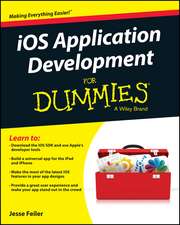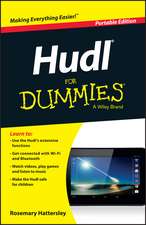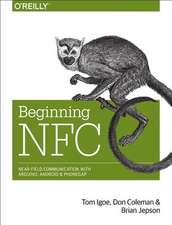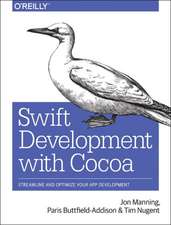Mobile Design and Development
Autor Brian Flingen Limba Engleză Paperback – 10 sep 2009
Preț: 174.80 lei
Preț vechi: 218.51 lei
-20% Nou
Puncte Express: 262
Preț estimativ în valută:
33.45€ • 35.08$ • 27.84£
33.45€ • 35.08$ • 27.84£
Carte disponibilă
Livrare economică 11-25 martie
Preluare comenzi: 021 569.72.76
Specificații
ISBN-13: 9780596155445
ISBN-10: 0596155441
Pagini: 332
Ilustrații: 1, black & white illustrations
Dimensiuni: 181 x 231 x 18 mm
Greutate: 0.59 kg
Editura: O'Reilly
ISBN-10: 0596155441
Pagini: 332
Ilustrații: 1, black & white illustrations
Dimensiuni: 181 x 231 x 18 mm
Greutate: 0.59 kg
Editura: O'Reilly
Cuprins
Preface; Who This Book Is For; How This Book Is Organized; Conventions Used in This Book; Using Code Examples; How to Contact Us; Safari® Books Online; Acknowledgments; Chapter 1: A Brief History of Mobile; 1.1 In the Beginning; 1.2 The Evolution of Devices; Chapter 2: The Mobile Ecosystem; 2.1 Operators; 2.2 Networks; 2.3 Devices; 2.4 Platforms; 2.5 Operating Systems; 2.6 Application Frameworks; 2.7 Applications; 2.8 Services; Chapter 3: Why Mobile?; 3.1 Size and Scope of the Mobile Market; 3.2 The Addressable Mobile Market; 3.3 Mobile As a Medium; 3.4 The Eighth Mass Medium: What's Next?; 3.5 Ubiquity Starts with the Mobile Web; Chapter 4: Designing for Context; 4.1 Thinking in Context; 4.2 Taking the Next Steps; Chapter 5: Developing a Mobile Strategy; 5.1 New Rules; 5.2 Summary; Chapter 6: Types of Mobile Applications; 6.1 Mobile Application Medium Types; Chapter 7: Mobile Information Architecture; 7.1 What Is Information Architecture?; 7.2 Mobile Information Architecture; 7.3 The Design Myth; Chapter 8: Mobile Design; 8.1 Interpreting Design; 8.2 The Mobile Design Tent-Pole; 8.3 Designing for the Best Possible Experience; 8.4 The Elements of Mobile Design; 8.5 Mobile Design Tools; 8.6 Designing for the Right Device; 8.7 Designing for Different Screen Sizes; Chapter 9: Mobile Web Apps Versus Native Applications; 9.1 The Ubiquity Principle; 9.2 When to Make a Native Application; 9.3 When to Make a Mobile Web Application; Chapter 10: Mobile 2.0; 10.1 What Is Mobile 2.0?; Chapter 11: Mobile Web Development; 11.1 Web Standards; 11.2 Designing for Multiple Mobile Browsers; 11.3 Device Plans; 11.4 Markup; 11.5 CSS: Cascading Style Sheets; 11.6 JavaScript; Chapter 12: iPhone Web Apps; 12.1 Why WebKit?; 12.2 What Makes It a Mobile Web App?; 12.3 Markup; 12.4 CSS; 12.5 JavaScript; 12.6 Creating a Mobile Web App; 12.7 Web Apps As Native Apps; 12.8 PhoneGap; 12.9 Tools and Libraries; Chapter 13: Adapting to Devices; 13.1 Why Is Adaptation a "Necessity"?; 13.2 Strategy #1: Do Nothing; 13.3 Strategy #2: Progressive Enhancement; 13.4 Strategy #3: Device Targeting; 13.5 Strategy #4: Full Adaptation; 13.6 What Domain Do I Use?; 13.7 Taking the Next Step; Chapter 14: Making Money in Mobile; 14.1 Working with Operators; 14.2 Working with an App Store; 14.3 Add Advertising; 14.4 Invent a New Model; Chapter 15: Supporting Devices; 15.1 Having a Device Plan; 15.2 Device Testing; 15.3 Desktop Testing; 15.4 Usability Testing; Chapter 16: The Future of Mobile; 16.1 The Opportunity for Change; Colophon;



















